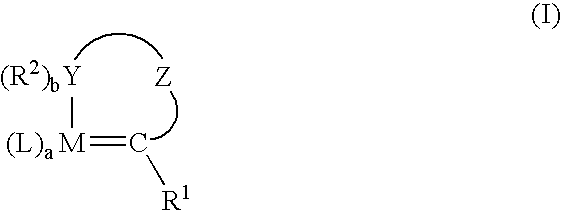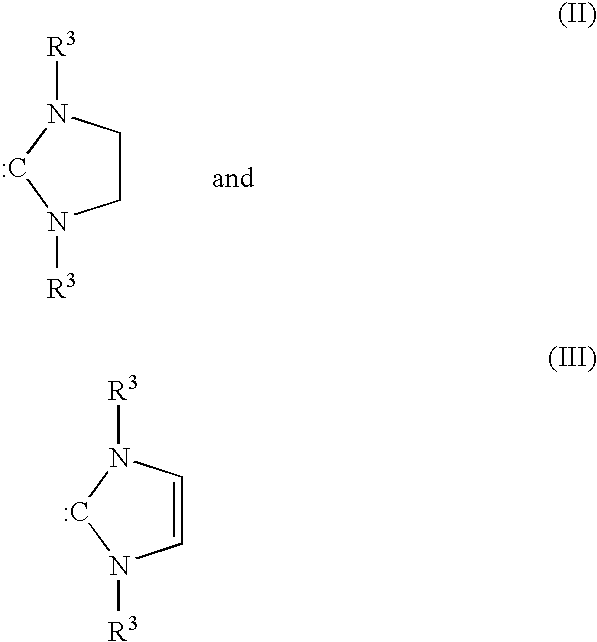Stabilization of olefin metathesis product mixtures
a technology of olefin metathesis and product mixture, which is applied in the preparation of organic compounds/hydrides/coordination complexes, physical/chemical process catalysts, carboxylic compound preparations, etc., can solve the problems of reducing product selectivity and waste of raw materials, unfavorable isomeric by-products, and reducing product selectivity and waste, so as to enhance product stability, easy to obtain adsorbents, and high metal removal efficiency
- Summary
- Abstract
- Description
- Claims
- Application Information
AI Technical Summary
Benefits of technology
Problems solved by technology
Method used
Image
Examples
examples 1-14
[0050] The general procedure for stabilizing an olefin metathesis product mixture and removing catalytic metals from said mixture is described as follows. The crude metathesis product mixture obtained hereinabove (10 ml aliquot) containing 65 parts per million ruthenium was stirred with an adsorbent (700 mg) under air for 3 hours at room temperature (22° C.) and ambient pressure. At the end of the contact period, the mixture was filtered through a Teflon™ brand tetrafluoroethylene fluorocarbon polymer filter (0.45 micron diameter) to yield the stabilized olefin metathesis product mixture. The ruthenium content of the stabilized mixture was analyzed by inductively-coupled plasma mass spectrometry (ICP-MS).
[0051] The above general procedure was carried out with each of the following adsorbents: Westvaco Nuchar™ SA brand wood carbon (Exp. 1), Westvaco Nuchar™ SA brand carbon that was once used (Exp. 2), Westvaco Nuchar™ SN brand wood carbon (Exp. 3), Westvaco Nuchar™ brand wood carbon...
examples 15-16
Evaluation of Metathesis Reaction Mixture Stability
[0053] To determine the stability of an olefin metathesis product mixture to olefin isomerization, two such product mixtures containing methyl 9-decenoate and a ruthenium concentration of 100 ppb (Ex. 15) and 423 ppb (Ex. 16), respectively, were heated to between 200-220° C. and monitored for olefin isomerization by gas phase chromatography analysis. Table 2 illustrates the impact of the heating cycle on the isomerization of methyl 9-decenoate.
TABLE 2Impact of [Ru] on Olefin Metathesis Product Mixture StabilityHeating% IsomerizedTemperatureMethyl 9-Example[Ru] (ppb)(° C.)Heating Time (h)Decenoate15a100210-2202.70.216b4232001.026.3CE-1c66,5001751.027.51754.048.1
aCrude Olefin Metathesis Product Mixture: 1-decene (19.8 area percent), methyl 9-decenoate (19.9 area percent), balance including solvent, methyl oleate, and homo-metathesis by-products (60.3 area percent), and [Ru] as shown.
bCrude Olefin Metathesis Product Mixture: 1-dece...
example 17
[0056] An olefin metathesis product mixture similar to that used in Example 1 hereinabove, comprising 1-decene, methyl decenoate, homo-metathesis by-products, toluene solvent, and ruthenium metathesis catalyst (65 ppm Ru) was subjected to a first short-path wiped-film evaporation to remove volatiles and lights, including toluene. The evaporator comprised a wiped-film evaporator with internal condenser having a distance from heated surface to cooled surface of 2 centimeters. The evaporator was operated at 115° C. and 30 mm Hg (39 kPa). Bottoms from the first evaporator were fed into a second short-path wiped-film evaporator similar in design to the first evaporator. The second evaporator was operated at higher temperature and lower pressure than the first, namely, 185° C. and 5 mm Hg (6.6 kPa). Residence time of the feed in the second evaporator was estimated to be about 15 to 20 seconds. 1-Decene, methyl decenoate, and roughly one-half of the methyl oleate in the bottoms feed were d...
PUM
| Property | Measurement | Unit |
|---|---|---|
| temperature | aaaaa | aaaaa |
| temperature | aaaaa | aaaaa |
| pressure | aaaaa | aaaaa |
Abstract
Description
Claims
Application Information
 Login to View More
Login to View More - R&D
- Intellectual Property
- Life Sciences
- Materials
- Tech Scout
- Unparalleled Data Quality
- Higher Quality Content
- 60% Fewer Hallucinations
Browse by: Latest US Patents, China's latest patents, Technical Efficacy Thesaurus, Application Domain, Technology Topic, Popular Technical Reports.
© 2025 PatSnap. All rights reserved.Legal|Privacy policy|Modern Slavery Act Transparency Statement|Sitemap|About US| Contact US: help@patsnap.com



